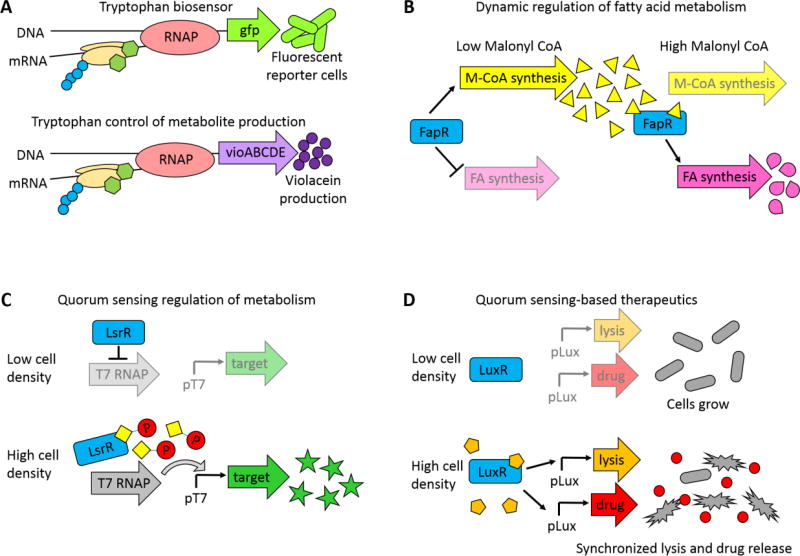Figure 3.
Examples of ways that metabolite signaling and regulation has been harnessed for metabolic engineering and therapeutic applications. (A) Tryptophan regulation of cell output. The genes of the tna operon, which naturally degrade tryptophan, were replaced with either GFP or the vioABCDE genes, which produce the purple pigment violacein from tryptophan. In the presence of tryptophan, tryoptophan binds to the ribosome to prevent premature transcriptional termination. Replacement of the naturally occurring genes with either reporter genes or metabolic pathways created a biosensor that reported on intracellular tryptophan levels and a dynamically controlled metabolic pathway that upregulated violacein synthesis in the presence of excess tryptophan. Adapted from Fang, et. al.68 (B) Dynamic regulation of fatty acid production to improve fatty acids yields. In the absence of malonyl-CoA (a precursor to fatty acids), the transcription factor FapR turns on the malonyl-CoA synthesis pathway and represses synthesis of fatty acids. When sufficient malonyl-CoA has accumulated, malonyl-CoA binds to FapR, and the FapR-malonyl-CoA complex then activates the fatty acid synthesis pathway. Adapted from Xu, et. al.70 (C) Cell-density dependent metabolite production. Target genes are expressed from a T7 promoter, which is only transcribed in the presence of T7 RNA polymerase (T7 RNAP). In low cell density, the transcription factor LsrR represses production of T7 RNAP, and the target genes are not expressed. Once the culture reaches a threshold cell density, phosphorylated autoinducer binds to LsrR, and LsrR no longer represses transcription of T7 RNAP. T7 RNAP then transcribes the target gene. Adapted from Tsao, et. al.71 (D) Cell-density dependent drug delivery. Genes for an anti-cancer drug and a lytic protein were placed under control of LuxR regulated promoters. In low cell density, these genes are not activated. Once the cells reach a threshold cell density, autoinducer binds to LuxR, turning on production of the drug and lytic protein. Synchronized lysis of cells delivers the drug to the surrounding environment, and a few unlysed bacteria enable reseeding and pulsatile treatment. Adapted from Din, et. al.72

